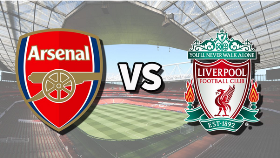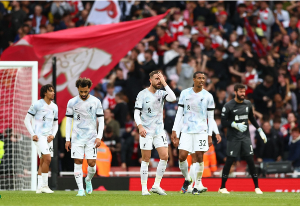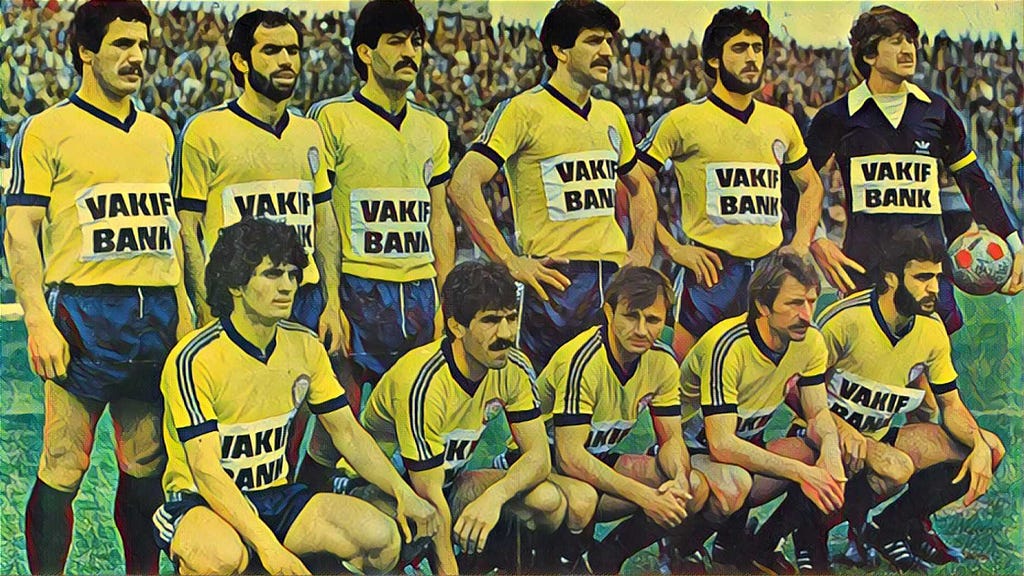Arsenal vs Liverpool – match analysis:: All Nigeria Soccer
Arsenal maintained their lead in the EPL thanks to a 3-2 home win over Liverpool. The Londoners’ highest-quality performance against Jurgen Klopp’s side was traditionally challenging to play with. However, a fair outcome highlighted the convergence of the teams in terms of level – it was made possible by the movement in two directions.
Let’s break down both Liverpool’s problems and Arsenal’s growth. If you want to play a game on the subject of soccer – Bollywood India has something to surprise you.
Takehiro Tomiyasu’s role.
Arsenal had one surprise in the lineup – Takehiro Tomiyasu as a left-back. Aleksandr Zinchenko is injured – he was not even in the squad, but he was very bright in the stands celebrating the team’s goals. Kieran Tierney usually substitutes him, but Mikel Arteta chose a non-standard option in the form of Tomiyasu.
Perhaps the coach wanted to block Mo Salah’s preferred direction for shifting – it’s easier for a right-back on the left flank. In common parlance, it’s called Messi/Arbeloa.
Klopp opted for a 4-2-3-1 (4-4-2) formation
This scheme was used against the Rangers. The filling in of this formation was entirely expected. The main intrigue concerned the choice of building. An indirect victim of the rejection of the 4-3-3 was Fabinho, who is in terrible shape.
The match can be divided into three phases.
- The first half was a bit strange. Arsenal scored early and late, but in between those goals, Liverpool was in control (albeit without many chances). The visitors responded quite well to a quick miss. They reclaimed territory and penetrated the sensitive areas. At the same time, one of the factors of the advantage could be the immediate goal itself – and the impact it inevitably has on the behavior of the teams.
- The start of the second half was the most impressive part of Arsenal’s performance. With the score 2-1 in their favor, Arteta’s team did not clamp down or even be cautious but pressed much more actively than in the first half – taking complete control from Liverpool, who needed to get back into the game. You don’t see that often, even at City (discounting Liverpool’s fortunes). Roberto Firmino’s goal did not take the course of the game. In the stretch from the start of the half to the 75th minute, it was Liverpool’s only shot (versus Arsenal’s 8). The home side didn’t break down and legitimately got the upper hand.
- In the final phase, Arsenal gave up territory but adapted their scheme (switched to a three-central) and did not allow any challenging moments.
Arsenal opened the scoring in a quick attack.
The episode happened too early to talk about trends but highlighted a problem that Liverpool repeated in different forms in all matches – the reaction to loss and meeting attacks at speed.
In the traditional 4-3-3 scheme, Fabinho plays a significant role in this process. The other two midfielders react immediately and play on the ball. Fabinho performs the function of a reading player – sometimes, he closes the pressure and sometimes holds the zone. This time in such episodes, we lacked a reading player. Tiago Alcantara and especially Jordan Henderson did not adapt the manner (it is challenging to do instantly) – we were getting episodes of a similar plan (four players in one point, including a pair of support and a hole in the consent).
Henderson regularly threw himself at the ball at such moments without assessing the situation, then exposed other areas. Tiago is not as mobile in principle – the bulk of the work without the ball should have gone to Hendo. As a result, it was easier for Arsenal to deliver the ball to Martinelli, who decided in such episodes.
The old scheme with Fabinho in his current form was regularly failing. Of course, I’m not saying it would have been better, but at this particular stage, a player of his type was lacking.
Reacting to losses was Liverpool’s main problem in the match.
Arsenal’s goals were to deliver the ball to the right wing in the final stages. It wasn’t just in the goal-scoring episodes.
It’s worth differentiating between Trent and Gomez not playing their best in difficult situations and the broader problem. Klopp has said it many times – people reduce everything to his mistakes when they are part of the bigger picture. Yesterday’s match is a good example – difficult situations were created because of a broader problem, and the right defenders could not put out the fire.
In the first goal, Alexander-Arnold was incredibly ridiculous trying to intercept a pass rather than finish the episode with Martinelli (post facto, of course, it’s evident to everyone how he should have). Still, the real problem is the ratio in Arsenal’s favor in that area is 4-on-1 or at least 2.5-on-1. Trent was choosing between bad decisions, let alone a terrible one.
It was Liverpool’s transition problems that sponsored Martinelli’s posh match. Gomez and Alexander-Arnold are scapegoats. They could have avoided that fate, but they needed to play outright grandiose and regularly put out other people’s fires.
After a quick miss, Liverpool seized control until the end of the first half. The key reason was the freedom Virgil van Dijk was getting in the first leg. Arsenal was positioned to press but had severe pressure problems in the Van Dijk/Tiago area.
Virgil van Dijk was getting an obscene amount of time to find options. Tiago was given freedom down the chain if Saka was promoted. Arsenal was not able to close this gap. Liverpool piled on the pressure.
Martinelli is Klopp’s idol and the star of the match.
“I am amazed by his willingness to train every day. Playing against him is a nightmare. In Martinelli, we always have a threat in attack,” enthused Arteta.
Gabriel Martinelli is Arsenal’s main attacker, focusing on individual action. Arteta maximizes his qualities. Tomiyasu did not play false (like Zinchenko) but stayed as the third center-back when he played. It made the flank less mobile and more predictable. Still, it played in Arsenal’s favor – the number of Martinelli’s face-offs increased.
Conclusion
Arsenal at least temporarily replaced Liverpool as Man City’s main rival. Liverpool is temporarily trying on the role of Arsenal, a club with an unmistakable style but a lack of understanding of how to implement it (the team is in search).
We do not have much reason to consider the changes permanent and irreversible (especially in the case of Liverpool, which is likely even this season to return to more normal positions). But they are also not accidental. This time Arsenal did not just beat Liverpool but played better soccer.





